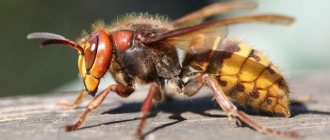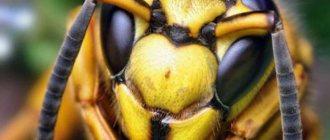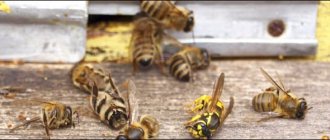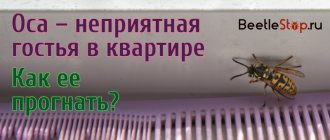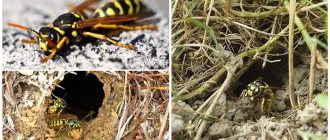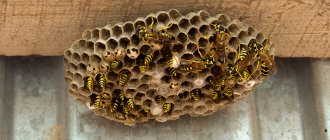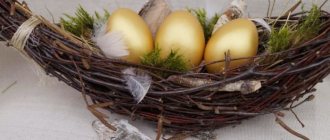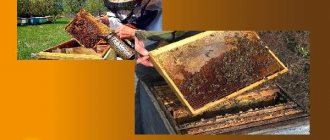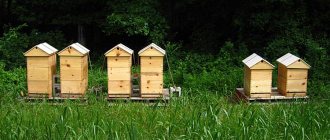From mid-April, when the air temperature warms up to +10 degrees and above, representatives of wildlife wake up from hibernation and harm humans with their presence. And if you can still put up with the bites of the same mosquitoes, then “large wasps” (hornets) and “small wasps” (common) are distinguished by their particular aggression and toxicity of the poison introduced into the body along with the bite.
The hornet, if left undisturbed, rarely attacks humans
The structure of a hornet's nest
Hornets can rightly be called real architects. The hive is created practically and thoughtfully. The nests are spherical or cone-shaped. The average size is 30 to 50 cm wide and 50 to 70 cm long. Sometimes you can find a large dwelling over 1 m. It usually weighs up to 1000 g.
The nest can be compared to a multi-story building, which has a huge number of apartments and several entrances. The rooms are honeycombs. The role of entrances is performed by compartments. There is a thin partition between the compartments.
The tiers are located in a perpendicular position. This is where the uterus moves. They are held together by several legs. One dwelling has 3 or 4 compartments. The number of tiers is from 7 to 10. The structure is neat and airy.
Hornets nest.
Insecticidal repellent lamps
Insecticidal lamps are designed to kill and repel flying insects. They are safe, do not emit harmful substances, have no odors, and can be used around the clock in the presence of people and animals.
The lamp consists of two blocks - one attracts insects using UV lamps, the second serves to destroy them. Attracted by the light, the insect flies towards the lamp and lands on a live grid or on a plate with glue (adhesive insecticidal lamps).
Classification by purpose:
- professional outdoor, for public spaces;
- household street, for home, apartment;
- industrial for production facilities, farms;
- mobile (battery operated).
The household lamp is equipped with a tray and a special grille that prevents accidental contact with live parts; the body is made of high-quality plastic. Devices for home use are usually small in size and easy to carry.
Brands in demand among the population: Hilton, Mo El, Well, Zapplight.
How to detect a hornet's nest
Insects are not capable of causing harm to humans unless touched. They do not destroy or destroy hives located in a natural area and away from people. The hornet is an inhabitant of the wild and performs its function.
However, when settling near a person, you need to be vigilant. Such neighbors are very dangerous.
- Insect infestations pose a mortal danger to bees. This threatens the destruction of apiaries. Hornets destroy larvae and adults, and also consume honey.
- The search for the hive begins at the initial stage of formation. The founder of the home is the queen. Thanks to the queen, the first tier is laid and eggs are laid in the honeycomb.
- Timely detection guarantees easy destruction. Within a few weeks, a large number of individuals appear, which are more difficult to control.
- The hornet prefers a quiet, secluded place that is protected. Such places can be holes, barns, attics, abandoned buildings, hollows in trees.
Search organization includes:
- carrying out training. Take antiallergic medications with you. Special protective thick clothing is required;
Hornet's nest.
- the study begins with an examination of all secluded places in the house. The nest can be found in a window frame, in a wall, or under the floor. These are the most inaccessible places;
- Conducting an inspection of the entire site. They explore holes, stumps, logs, trees;
- listening - insects make a lot of noise when building a home;
- insect mark - a bright thread or ribbon is attached to the caught hornet and its further flight is monitored.
How to get rid of it
Huge hornet nest.
After finding the hive, the degree of danger is determined. When located in a corner, do not touch the nest.
But if it is in an accessible place, then it is necessary to get rid of it. This is difficult and dangerous, as the insects defend themselves aggressively.
The most effective methods of elimination include:
- treatment with insecticides;
- burning;
- pouring boiling water;
- heating.
The methods can be called cruel and risky. They are used as a last resort.
Peculiarities
Wasp stings rarely cause anything other than pain to a person.
We are talking about complications, they occur only in people with allergies. However, hornet attacks are much more sensitive and serious than wasp stings. Severe consequences of encountering these insects especially often occur in older people and children. Here are a few reasons why a hornet bite is quite dangerous:
- it is considered one of the most painful among insects;
- can cause an acute allergic reaction;
- causes swelling and inflammation;
- can cause severe poisoning of the body.
Such poisoning is characterized by: rapid heartbeat, migraines (severe pain), hemorrhages. It is even possible to experience anaphylactic shock, which requires qualified medical care.
Hornets are ready to do anything to protect their nest from uninvited guests. Any threat puts adult individuals of this insect species on alert.
As a rule, hornet attacks on humans are associated solely with the fact that they see him as a threat to their nest and swarm. They can hardly be called peace-loving insects, but when it comes to home safety, they have no equal.
Number of individuals living in one nest
The number of insects is influenced by a comfortable location, weather conditions, and food. The number of adults in one family ranges from 400 to 600.
Optimal conditions are calm, quiet, warm places with plenty of food. In this case, the diameter of the nest exceeds 1 m and accommodates from 1000 to 2000 individuals.
Hornets nests.
Non-standard way
Don't have time to lure and feed hornets with minced meat containing arsenic? Aggressive individuals are lured out of the nest with a vacuum cleaner. You will need an older model with a fabric dust collector and a long tube.
The equipment is turned on and brought closer to the entrance to the cocoon. The hornets, sensing danger, begin to attack the plastic pipe, which sucks them inside the dust collector. What to do with caught insects? You can quickly shake it into a bag and burn it, or leave it inside the vacuum cleaner, plugging the tube with a rubber stopper or rag.
Hornets are dangerous neighbors. They are aggressive and large, and one bite from a predatory insect can kill an adult. You need to fight striped invaders carefully, carefully thinking through every step. And if there are a lot of hornets, and they carefully guard the queen and the nest, it is better to call a team of experienced exterminators.
Nest construction
Device
The hive is always durable and comfortable. It is not afraid of heat and cold. Insects build homes from wood and bark. Particular preference is given to birch. In this regard, the hives are lighter than those of other wasps.
Materials
The hornet thoroughly chews the wooden pieces, moistening them with saliva. The resulting material is the basis of honeycombs, walls, partitions, and shells.
Place
The choice of location depends on the uterus. It is from here that the construction of the future house begins. She prefers remote places, peace and solitude.
Process
Initially, the first ball is sculpted from the cells. Eggs are laid in the cells. After 7 days, larvae appear, which after 14 days turn into pupae. After another 14 days, young working insects leave the house and also participate in construction.
Peculiarities
Individuals are very hardworking and disciplined. Their self-organization is at a very high level. More productive work of young hornets affects the number of individuals. When the worker insects leave the hive, eggs are laid.
Security measures
If you are going to treat a swarm or habitat, you should protect yourself from bites, since the disturbed “residents” are very aggressive. There is no need to make noise, knock, wave your arms, or shine a flashlight - all these factors will attract hornets and wasps. It is recommended to take action while it is dark - activity decreases in the dark.
What to do:
- wear thick, thick clothing that covers all parts of the body, a hat, a mesh face mask, rubber gloves, and glasses;
- when using spraying substances, wear a respirator;
- bring everything in advance so as not to make noise in the dark;
- observe safety precautions when working with fire;
- take with you first aid supplies for a bite (ice, hydrogen peroxide, alcohol or vodka, antihistamines);
- in the event of an attack, do not run, do not panic, do not wave your arms or rags, but calmly move away.
If you had to prepare poisonous agents yourself, then the containers cannot be used for food or drinking water.
Insects flying out of the hive
During autumn the house becomes empty. This is influenced by a number of nuances:
- after the start of swarming, males die very quickly;
- cold and frost kill worker hornets and the queen, and fertilized individuals move to warm places;
- in the fall, the female produces a special enzyme that prevents her from freezing in a state of suspended animation in winter;
- choose a temporary home - a hollow, a tree, an outbuilding;
- The hornet does not settle in an old nest; the construction of a new house always begins.
Neutralization and destruction of nests
To ensure you get rid of pests, destroy the nest. To find it, it is enough to follow the flight of insects, and then, depending on the location, choose the optimal method of destruction.
Sealing the nest
To destroy the hornets' home, use polyurethane foam. At night, when pests are less active, treat the hive with a sealing compound, thoroughly filling all cracks and holes. The lack of oxygen and the ability to fly out for food will lead to the extinction of all individuals.
To destroy the nest and its inhabitants, seal the evidence. This can be done with polyurethane foam or other sealing compound.
Pouring water
To flood the nest, prepare a bucket filled with water. For maximum effect, add an insecticide designed for wasps and hornets to the liquid. Place a bucket under the nest and gently lower it into the water. The liquid will fill the honeycombs and the insects will not be able to get out of their house, which will lead to their death.
Burning out with fire
Fire will help get rid of a pest nest located in an open area. Douse the home with a flammable mixture (gasoline) and set it on fire. During the operation, make sure that the flame does not spread to trees, dry grass or outbuildings, otherwise you will have to fight not only pests, but also the fire.
Smoke bomb
A smoke bomb (Mukhoyar, FAS, HELP, etc.) will help destroy the nest. The application procedure is as follows:
- Insulate the room and seal all cracks so that insects cannot escape.
- Make sure that there are no children, pets, or food near the treatment area.
- Activate the smoke bomb according to the instructions.
- Clean the room.
Smoke bombs will help control pests. Before use, carefully read the instructions and take the recommended safety measures
Traps and bait
Traps with bait will help get rid of single insects remaining after the destruction of the nest. You can make them yourself using available tools and materials. Spoiled fish, a mixture of honey and beer, and fermented fruit syrup are used as bait.
The simplest trap option is sticky tape, which is used to catch flies and cockroaches. You can do it yourself:
- Cut out small strips of thick cardboard.
- Apply a generous layer of honey or fruit syrup. This will serve as both bait and a trap for insects to stick to.
- Place bait in areas where hornets frequently appear.
- Replace traps periodically and burn old ones.
Homemade traps with bait located in places where insects are active will help you catch single pests.
You can make other traps with your own hands:
- put the bait in a glass jar and close it with a lid with a hole in the shape of a cross and the edges of the cut curved inward;
- Cut off the top of a plastic bottle (1/3) and insert it back with the neck down. Fill the bottom reservoir with bait and place the trap in a visible place;
- Pour the fermented fruit syrup into a large container (bucket) and leave it near the pest habitat.
Why do they attack?
These representatives of the wasp family are not as aggressive as wasps and bees; they will not attack without a good reason, and will try to stay as far away from humans as possible. Most often, the reason for attacks is threats to their home or the individual itself.
It is important to understand that unjustified destruction of beehives is a bad idea, since many of the species are rare and are at the stage of extinction, some of them are listed in the Red Book. It is worth fighting them when there is a risk of presenting a danger to human health.
Providing first aid for a bite
If a person does suffer from a hornet bite, it is necessary to take action as quickly as possible in order to prevent possible complications of the victim’s condition.
First aid must be provided in the following order:
- Suck out the poison from the affected area on the skin - this procedure must be carried out immediately, since effectiveness is possible only within a short time from the moment of attack until the poison spreads through the blood. Of course, this will not prevent all consequences and will not eliminate the risk of allergies, but it will significantly reduce the intensity.
- Apply ice or something cold to the bitten area - this action will reduce pain and prevent swelling from growing.
- Do not touch the affected area, as any rubbing or scratching of the wound will help stimulate blood circulation, which maximizes the rate of spread of the poison throughout the body, and there is also a risk of infection, which will only worsen the victim’s condition. Do not try to find the sting, since the hornet, due to its smooth surface, will not leave it in the wound (unlike a bee).
- Disinfect the affected area of the skin using any available method - you can use hydrogen peroxide, medical alcohol or other disinfectants. The bite should be treated with the utmost care, excluding any pressure.
- Apply wet sugar to the bite area, having previously wrapped it with a bandage or towel - this action makes it possible to draw out a certain amount of poisonous components that have not yet had time to disperse throughout the human body. Remove the bandage after 10 minutes - this period is enough to draw out the possible amount of poison.
- Take a swab, pre-moisten it with citric acid/vinegar and apply it to the affected area - the procedure will reduce the inflammatory process and reduce the intensity of the allergic reaction. This is done due to the fact that toxic substances contain alkali, and acid can destroy the structure.
- If there are pronounced consequences of the attack, severe discomfort and no improvement in the condition for several days, this is a serious reason to seek urgent help from a specialist to receive professional medical care.
Glue-based trap, dummy
You can purchase a glue trap or make it yourself. To do this, you will need cardboard and special glue, for example, RaTrap or Alt. The paper sheet must be lubricated with adhesive. The layer should not be too thin, but not too thick. In order for the insects to fall into the trap, you need to put bait in the middle . Suitable for this:
- meat;
- fish;
- rotten fruit.
Such a trap has the following operating principle: hornets fly towards a treat, land on the cardboard and stick to its surface. They cannot free themselves and die. When the paper is filled with pests, all you have to do is throw it away. If you want to remove a hornet nest from the attic in the fall or at other times of the year, you can place several similar cardboard boxes there. This will allow you to quickly get rid of hated pests.
Now you can find special dummies of nests on sale. If placed in the attic, they will repel insects that do not settle nearby another swarm.
In addition, one of the enemies of hornets is the bat, so it is quite possible to use repellent devices that emit ultrasound and repel pests.
What to do if bitten
First of all, you need to have an antiseptic, an antihistamine, and a compress. First, you should drink a drug that neutralizes the effect of histamines in the body’s blood (comes with the poison).
Suprastin is best suited - this remedy makes it possible to relieve swelling and reduce the intensity of allergic symptoms. The affected area on the skin should be treated with alcohol and hydrogen peroxide.
After such manipulations have been performed, apply a cold compress to the affected area of the victim - this will reduce the rate of spread of the poison through the blood. With proper preparation for the process of destroying a hornet's nest (thick, covered clothing, gloves, a beekeeper's mask with a net), the likelihood of being attacked by stinging insects is reduced to a minimum.
